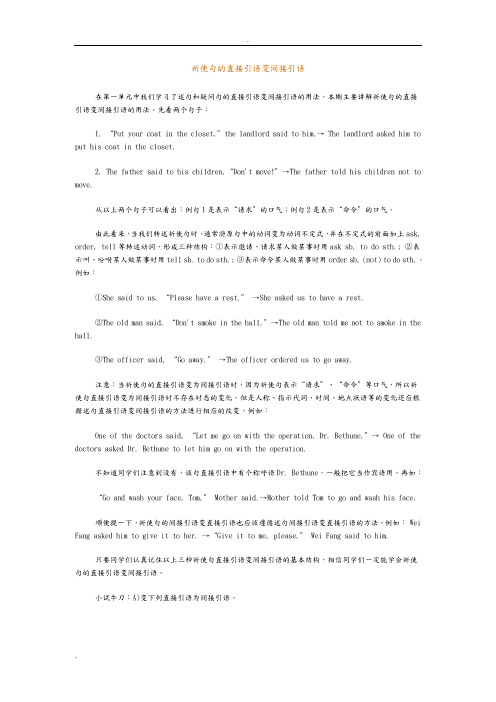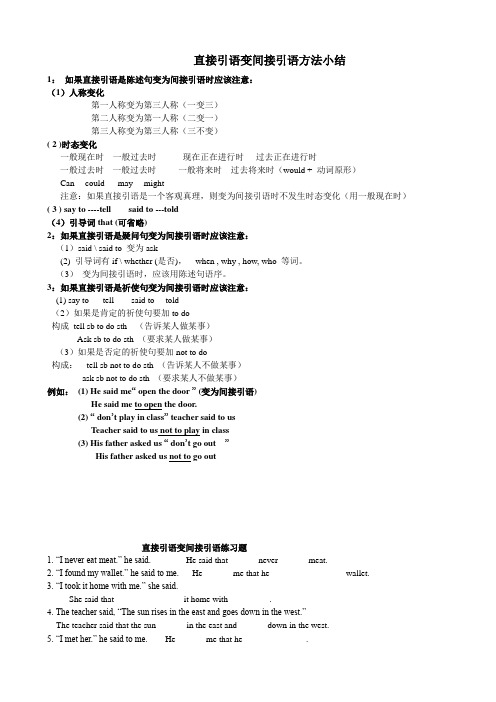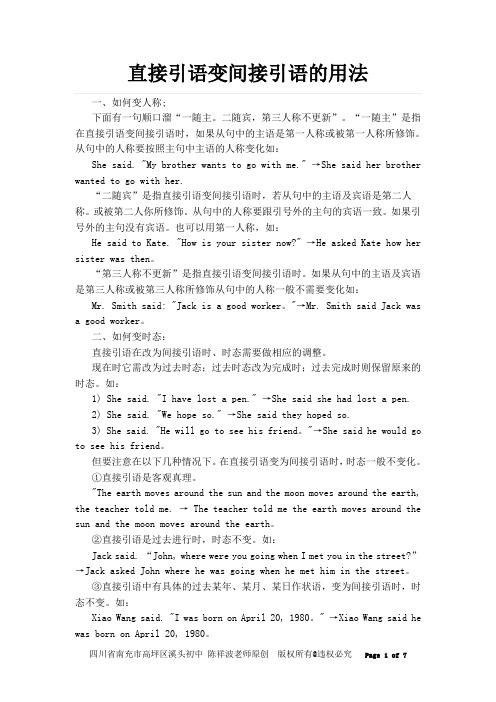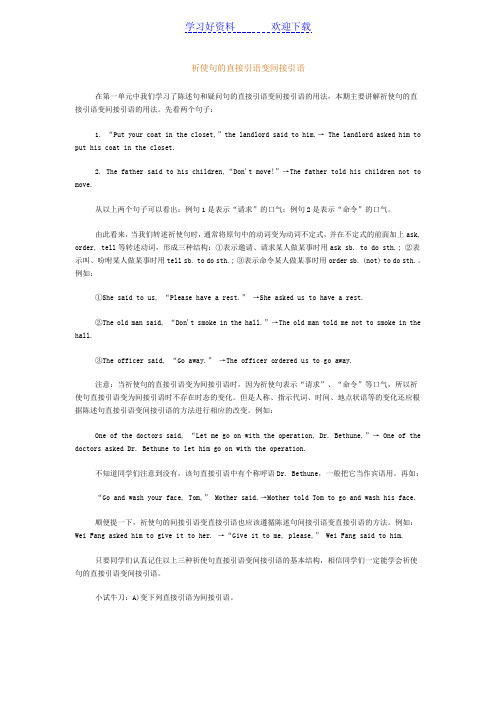直接引语的祈使句变间接引语的方法
- 格式:doc
- 大小:24.00 KB
- 文档页数:1

祈使句的直接引语变间接引语在第一单元中我们学习了述句和疑问句的直接引语变间接引语的用法,本期主要讲解祈使句的直接引语变间接引语的用法。
先看两个句子:1. “Put your coat in the closet,”the landlord said to him.→ The landlord asked him to put his coat in the closet.2. The father said to his children,“Don't move!”→The father to ld his children not to move.从以上两个句子可以看出:例句1是表示“请求”的口气;例句2是表示“命令”的口气。
由此看来,当我们转述祈使句时,通常将原句中的动词变为动词不定式,并在不定式的前面加上ask, order, tell等转述动词,形成三种结构:①表示邀请、请求某人做某事时用ask sb. to do sth.; ②表示叫、吩咐某人做某事时用tell sb. to do sth.; ③表示命令某人做某事时用order sb. (not) to do sth.。
例如:①She said to us, “Please have a rest.” →She asked us to have a rest.②The old man said, “Don't smoke in the hall.”→The old man told me not to smoke in the hall.③The officer said, “Go away.” →The officer ordered us to go away.注意:当祈使句的直接引语变为间接引语时,因为祈使句表示“请求”、“命令”等口气,所以祈使句直接引语变为间接引语时不存在时态的变化。
但是人称、指示代词、时间、地点状语等的变化还应根据述句直接引语变间接引语的方法进行相应的改变。

直接引语变间接引语方法小结1:如果直接引语是陈述句变为间接引语时应该注意:(1)人称变化第一人称变为第三人称(一变三)第二人称变为第一人称(二变一)第三人称变为第三人称(三不变)( 2 )时态变化一般现在时---一般过去时现在正在进行时----过去正在进行时一般过去时---一般过去时一般将来时---过去将来时(would + 动词原形)Can ---could may ---might注意:如果直接引语是一个客观真理,则变为间接引语时不发生时态变化(用一般现在时)( 3 ) say to ----tell said to ---told(4)引导词that (可省略)2:如果直接引语是疑问句变为间接引语时应该注意:(1)said \ said to 变为ask(2) 引导词有if \ whether (是否),when , why , how, who 等词。
(3)变为间接引语时,应该用陈述句语序。
3:如果直接引语是祈使句变为间接引语时应该注意:(1) say to ----tell said to ---told(2)如果是肯定的祈使句要加to do构成tell sb to do sth (告诉某人做某事)Ask sb to do sth (要求某人做某事)(3)如果是否定的祈使句要加not to do构成:tell sb not to do sth (告诉某人不做某事)ask sb not to do sth (要求某人不做某事)例如:(1) He said me“ open the door ” (变为间接引语)He said me to open the door.(2) “ don’t play in class” teacher said to usTeacher said to us not to play in class(3) His father asked us “ don’t go out ”His father asked us not to go out直接引语变间接引语练习题1. “I never eat meat.” he said. He said that ______ never ______ meat.2. “I found my wallet.” he said to me. He ______ me that he ______ ______ wallet.3. “I took it home with me.” she said.She said that ______ _______ it home with _________.4. The teacher said, “The sun rises in the east and goes down in the west.”The teacher said that the sun ______ in the east and ______ down in the west.5. “I met her.” he said to me.He ______ me that he ______ ______.6. “You must come here .” he sai d. He said that ______ ______ come here..7. “I bought the house 10 years ago.” he said.He said that _____ _______ bought the house 10 years ago8. “Did you see her?” he said.He ______ ______ _____ had seen her9. He said, “You can sit here, Jim.”He ______ Jim that_____ ______ sit there10. He asked, “How did you find it, mother?”He asked her mother ______ ______ ______ it.11. “Where have you been” he asked.He asked me _______ _______ _______been.12. “Do you know where she lives?” he asked.He asked ______ ______ knew where she ______.13. “Stop making so much noise, children.” he said.He ______ the children ______ ______ making so much noise.14. “Don’t tell him the news.” she said.She told me _______ ______ ______ him the news.15. “Are you interested in this book ?” he said.He ______ ______ I was interested in that book16.He said: “I’ve left my book in my room.”He said _____ _______ left ______book in _______room17.She sai d: “He will be busy.”She said _____ _____be busy18.She said to Tom, “Can you help me?”She said to Tom _____ _____ ______help _______19.She asked, “are you interested in this book ?”She asked _______ _____ _____ interested in that book20.The teacher asked, “how did you repair it?”The teacher asked ________ _______ ________ it .21.The teacher said to the students, “Don’t waste your timeThe teacher ________the students ________ ______ waster _________ time。

直接引语变间接引语的用法由直接引语变为间接引语,分以下情况:1、直接引语是陈述句时间接引语为that引导的宾语从句(口语中that可以省略),主句的引述动词主要有say ,tell, repeat, explain, think等。
He said, "You are younger than I.” He said (that) I was younger than him.2、直接引语是疑问句时间接引语为陈述语序:主句的谓语动词say 改为ask,或改为wonder, do not know, want to know, be not sure, be puzzled等。
(1)一般疑问句或反意疑问句变为if (whether)引导的宾语从句。
She said, "Do you often come here to read newspapers?"→She asked me if (或whether)I often went there to read newspapers.She asked me, "You have seen the film, haven’t you?"→She asked me whether(或if )I had seen the film.(2)选择疑问句变为whether….or 宾语从句。
I asked him, "Will you stay at home or go to a film tonight?"→I asked him whether he would stay at home or go to a film that night.(3)特殊疑问句变为由原来的疑问词引导的宾语从句。
He asked, "Where do you live?" →He asked me where I lived.3、直接引语是祈使句时间接引语为不定式,作ask , tell, beg, order, warn, advise等动词的宾语补足语(don’t 变为not ).The teacher said to the boy, "Open the window." →The teacher told the boy to open the window. His father said to him, “Don’t leave the door open.” →His father told him not to leave the door open.[注意](1)有些表示建议、提议、劝告或要求的祈使句,可以用suggest ,insist等动词加以转述。

直接引语和间接引语转化详解引用别人的话有两种方式,一种是讲述别人的原话,并把它放在引号里,这叫直接引语;另一种是用自己的话来转述别人,并且不能用引号,这就是间接引语。
直接引语和间接引语之间可以互相转换。
扩展1、直接引语如果表示客观真理,变间接引语时,时态不变。
2、直接引语若有明确的表示时间的词语,变间接引语时,时态不变。
3、若直接引语中含有c o u l d,m u s t,s h o u l d等情态动词,变间接引语时,时态不变。
4、直接引述别人的原话,叫直接引语。
5、用自己的话转述别人的话,叫间接引语。
直接引语变间接引语的五点变化1.时态变化直接引语变为间接引语时,若主句为过去时态,变为宾语从句的时态如下表:"l l i k e E n g l i s h v e r y m u c h,"h e s a i d.他说:“我很喜欢英语。
”→H e s a i d t h a t h e l i k e d E n g l i s h v e r y m u c h.H e s a i d,"I t w i l l r a i n s o o n."他说:“很快就会下雨。
”→H e s a i d t h a t i t w o u l d r a i n s o o n.注意:[1]若直接引语为客观真理,则变为间接引语时时态不变:T h e t e a c h e r s a i d t o u s,"K n o w l e d g e i s p o w e r."老师对我们说:“知识就是力量”→T h e t e a c h e r t o l d u s t h a t k n o w l e d g e i s p o w e r.[2]有时由于直接引语有特定的过去时态状语,变为间接引语时时态也可不变:H e s a i d,”M y d a u g h t e r w a s b o r n i n1997."他说:“我的女儿是1997年出生的。

直接引语变间接引语的用法一、如何变人称;下面有一句顺口溜“一随主。
二随宾,第三人称不更新”。
“一随主”是指在直接引语变间接引语时,如果从句中的主语是第一人称或被第一人称所修饰。
从句中的人称要按照主句中主语的人称变化如:She said. "My brother wants to go with me." →She said her brother wanted to go with her.“二随宾”是指直接引语变间接引语时,若从句中的主语及宾语是第二人称。
或被第二人你所修饰。
从句中的人称要跟引号外的主句的宾语一致。
如果引号外的主句没有宾语。
也可以用第一人称,如:He said to Kate. "How is your sister now?" →He asked Kate how her sister was then。
“第三人称不更新”是指直接引语变间接引语时。
如果从句中的主语及宾语是第三人称或被第三人称所修饰从句中的人称一般不需要变化如:Mr. Smith said: "Jack is a good worker。
"→Mr. Smith said Jack wasa good worker。
二、如何变时态:直接引语在改为间接引语时、时态需要做相应的调整。
现在时它需改为过去时态;过去时态改为完成时;过去完成时则保留原来的时态。
如:1) She said. "I have lost a pen." →She said she had lost a pen.2) She said. "We hope so." →She said they ho ped so.3) She said. "He will go to see his friend。
"→She said he would go to see his friend。

祈使句的直接引语变间接引语在第一单元中我们学习了陈述句和疑问句的直接引语变间接引语的用法,本期主要讲解祈使句的直接引语变间接引语的用法。
先看两个句子:1. “Put your coat in the closet,”the landlord said to him.→ The landlord asked him to put his coat in the closet.2. The father said to his children,“Don't move!”→The father t old his children not to move.从以上两个句子可以看出:例句1是表示“请求”的口气;例句2是表示“命令”的口气。
由此看来,当我们转述祈使句时,通常将原句中的动词变为动词不定式,并在不定式的前面加上ask, order, tell等转述动词,形成三种结构:①表示邀请、请求某人做某事时用ask sb. to do sth.; ②表示叫、吩咐某人做某事时用tell sb. to do sth.; ③表示命令某人做某事时用order sb. (not) to do sth.。
例如:①She said to us, “Please have a rest.” →She asked us to have a rest.②The old man said, “Don't smoke in the hall.”→The old man told me not to smoke in the hall.③The officer said, “Go away.” →The officer ordered us to go away.注意:当祈使句的直接引语变为间接引语时,因为祈使句表示“请求”、“命令”等口气,所以祈使句直接引语变为间接引语时不存在时态的变化。
但是人称、指示代词、时间、地点状语等的变化还应根据陈述句直接引语变间接引语的方法进行相应的改变。
••直接引语变间接引语口诀五则1.变陈述句,去掉引号加that, 时态全向后退过;人称变化看主语,其它变化背表格。
2.变一般疑问句,去掉引号请“if”,陈述语序要记住;时态人称后状语,全都要变别马虎。
3.变特殊疑问句,直接引语去引号,原句问词作引导;陈述语序助去掉,其它变化别漏掉。
4.变祈使句,动前加to去引导,tell, ask句型套;否认祈使一样变, not就往to前靠。
5.直转间人称变,一主二宾三不变。
【特别提示】“一主”是指直接引语为第一人称变间接引语时,须与主句的主语在人称和数上坚持一致;“二宾”是指直接引语是第二人称变间接引语后需与主句的宾语在人称上一致;“三不变”是指直接引语中的代词若是第三人称,变为间接引语时则不变.直接引语变为间接引语时,若主句为过去时态,变为间接引语的宾语从句通常要将时态往后推一个,即。
如:一般现在时变为一般过去时,一般将来时变为过去将来时,现在进行时变为过去进行时,现在完成时变为过去完成时,一般过去时也变为过去完成时,等等(若直接引语为过去完成时,变为间接引语可以不变)。
另外,若直接引语中有情态动词can, may等,也应变成过去式could, might等(情态动词must可以变为had to,也可不变,should, ought to, had better 等可以不变)。
如:“I want to stay here.”he said. 他说。
如:“我想留在这儿。
”→He said that he wanted to stay there. 他说他想留在那儿。
She said, “It’s raining very hard.”他说。
如:“雨下得很大。
”→He said that it was raining very hard. 他说雨下得很大。
Jim said, “I can speak Chinese.”吉姆说。
如:“我会讲汉语。
”→Jim said that he could speak Chinese. 吉姆说他会讲汉语注意:(1) 若直接引语为客观真理,则变为间接引语时时态不变。
直接引语和间接引语的转换方法引语是我们在写作中经常会用到的一种表达方式,它可以为我们的观点提供支持和证明。
在引语的使用中,有两种常见的形式:直接引语和间接引语。
直接引语是将别人的原话直接引用过来,而间接引语则是将别人的原话进行转述。
在写作中,我们需要根据具体情况选择使用哪种引语形式,下面将介绍一些直接引语和间接引语的转换方法。
首先,我们来看直接引语的转换方法。
直接引语是将别人的原话直接引用过来,需要用引号将其包裹起来,并标明出处。
当我们需要转换直接引语时,可以通过以下几种方式进行。
1. 改变时态:当我们将直接引语转换为间接引语时,通常需要改变时态。
例如,直接引语中的现在时可以转换为间接引语中的过去时,直接引语中的过去时可以转换为间接引语中的过去完成时等。
这样做可以使引语与整个文章的时态保持一致。
2. 改变人称:在转换直接引语时,我们还需要根据引语所述的对象来改变人称。
例如,如果直接引语中的第一人称变为了第三人称,那么在转换为间接引语时,我们也需要相应地改变人称。
3. 改变语气:有时候,我们需要将直接引语转换为间接引语时,需要改变语气。
例如,直接引语中的疑问句可以转换为陈述句,直接引语中的祈使句可以转换为陈述句等。
这样做可以使引语更好地融入到我们的文章中。
接下来,我们来看间接引语的转换方法。
间接引语是将别人的原话进行转述,不需要使用引号,并且需要注明出处。
当我们需要将间接引语转换为直接引语时,可以通过以下几种方式进行。
1. 添加引号:当我们将间接引语转换为直接引语时,需要在原话的前后添加引号,以示区分。
这样做可以让读者清楚地知道这是别人的原话,而不是我们自己的观点。
2. 删除转述词:在转换间接引语为直接引语时,我们通常可以删除转述词。
例如,原来的间接引语可能是“他说道”,而在转换为直接引语时,我们可以直接将原话进行引用,不再需要使用转述词。
3. 注意语气和语调:当我们将间接引语转换为直接引语时,需要注意语气和语调的转换。
Chaper5直接引语变间接引语学案班级________ 姓名________1. 直接引语为陈述句时如何变为间接引语方法是:将直接引语变为由that引导的宾语从句跟在引述动词之后(that也可省略):“I don’t love her.” he says. 他说:“我不爱她。
”→He says that he doesn’t love her. 他说他不爱她。
【注意】(1)若引述动词用的是say to sb,则通常改为tell sb:“It’s a secret.” he said to me. 他对我说:“这是秘密。
”→He told me that it was a secret. 他对我说那是秘密。
2. 直接引语为一般疑问句时如何变为间接引语方法是:将直接引语变为由if或whether引导的宾语从句跟在引述动词之后:“Are you ill?” he asked. 他问:“你病了吗?”→He asked if [whether] I was ill. 他问我是否病了。
【注意】(1)改为宾语从句的间接引语要用陈述句词序。
(2)若直接引语引述动词为say,改成间接引语应将其改为ask等。
3. 直接引语为特殊疑问句时如何变为间接引语方法是:将直接引语变为由“疑问词”引导的宾语从句跟在引述动词之后:He asked, “When did she leave?” 他问:“她什么时候离开的?”→He asked when she had left. 他问她什么时候离开的。
【注意】(1)改为宾语从句的间接引语要用陈述句词序。
(2)若直接引语引述动词为say,改成间接引语应将其改为ask等。
4. 直接引语为祈使句时如何变为间接引语方法是:使用ask [tell, order] sb to do sth这一结构进行转换,若祈使句为否定式,则用ask [tell, order] sb not to do sth,其中ask, tell, order的选择视句子的语气而定:“Come early tomorrow, Jim.” he said. 他说:“吉姆,明天早点来。
祈使句的直接引语变间接引语是重要语法点, 现作一小结。
当直接引语的句子是祈使句时, 间接引语常用动词不定式表示; 如果祈使句为否定式, 变为间接引语时, 则将原句变为动词不定式的否定式。
间接引语的动词应根据句子的意思和说话者的口气作相应的改变, 一般将原句的say酌情改为ask, beg, tell, order, demand等动词, 并在动词的后面加相应的人称作宾语。
为使间接引语的语气和意义更贴近原句, 可按下列情况酌情选用不同的谓语动词。
1. 一般情况将原句的动词say改为tell。
例如:①He said, “Hurry up!"→He told me to hurry up.他告诉我快一点。
②She said, “Don't put your bag here, Mary."→She told Mary not to put her bag there.她告诉玛丽不要把袋子放在那里。
③He said, “Never eat too much."→He told /warned us never to eat too much.他告诉我们永远不要吃得太多。
④The teacher said, “Don't be late again, Mary."→The teacher told Mary not to be late again.老师告诉玛丽不要再迟到了。
2. 有的祈使句含有please一词, 以表示婉转的语气, 将这类祈使句变为间接引语, 通常将原句的say改为ask或beg。
值得注意的是, please一词在改为间接引语时去掉。
例如:①Tom said to Alice, “Come here tomorrow, please."→Tom asked Alice to go there the next day.汤姆要求艾丽斯第二天去那里。